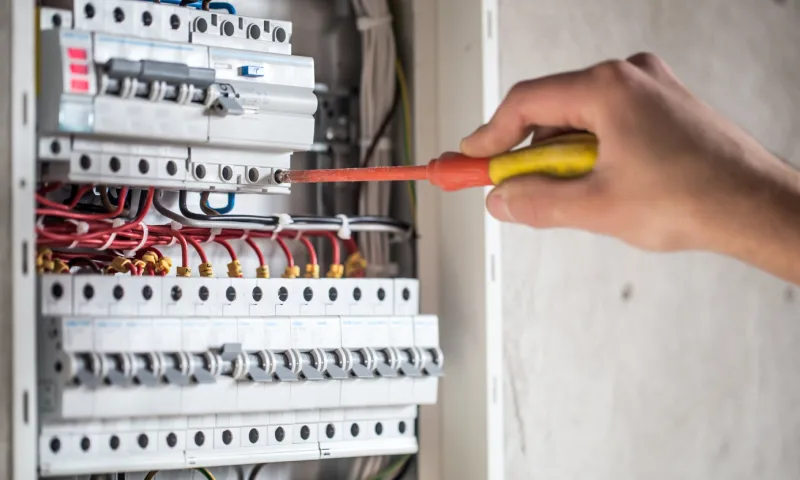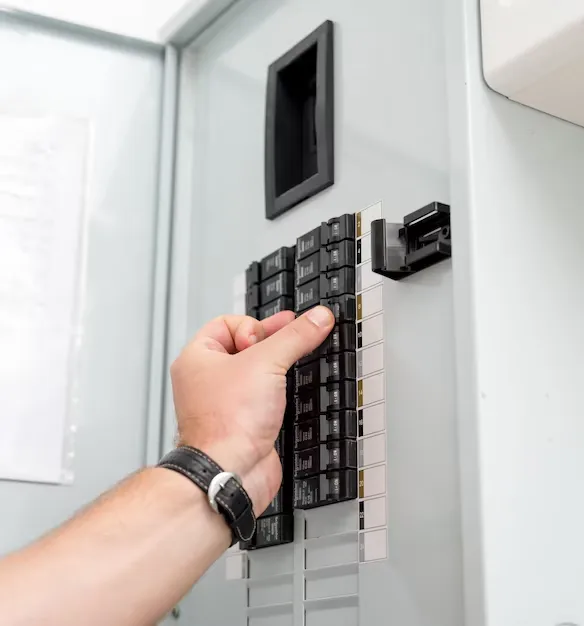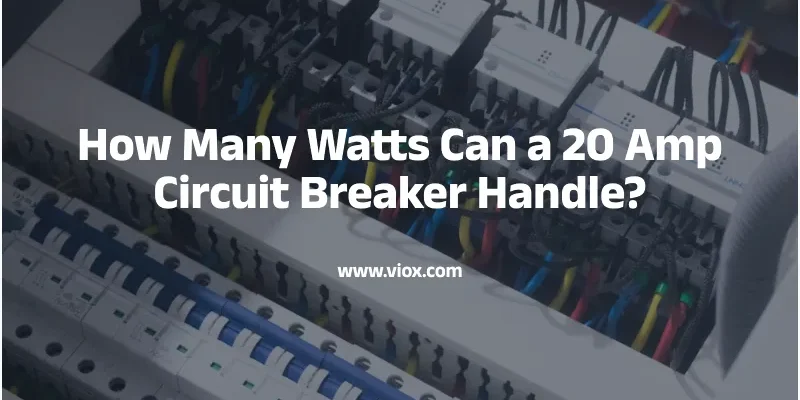Understanding the wattage capacity of a 20 amp circuit breaker is crucial for electrical safety and efficient home power management. Whether you’re planning a kitchen renovation, setting up a home office, or troubleshooting electrical issues, knowing your circuit’s limitations can prevent dangerous overloads and costly electrical problems.
Quick Answer: 20 Amp Circuit Breaker Wattage Capacity
A 20 amp circuit breaker can handle:
- 2,400 watts maximum on a 120V circuit
- 4,800 watts maximum on a 240V circuit
- 1,920 watts recommended for continuous loads (80% rule)

Understanding Electrical Fundamentals: Amps, Watts, and Volts
The Essential Electrical Formula
The relationship between amperage, wattage, and voltage follows Ohm’s Law:
Power (Watts) = Current (Amps) × Voltage (Volts)
This fundamental formula determines how much electrical power your 20 amp breaker can safely deliver:
| Tension | Maximum Watts | Recommended Continuous Watts |
|---|---|---|
| 120V | 2,400W | 1,920W |
| 208V | 4,160W | 3,328W |
| 220V | 4,400W | 3,520W |
| 240V | 4,800W | 3,840W |
Why Voltage Matters in Wattage Calculations
Different household circuits operate at various voltages:
120V Circuits (Standard Household)
- Bedroom outlets
- Living room receptacles
- Most lighting circuits
- Small appliances
240V Circuits (High-Power Applications)
- Electric dryers
- Central air conditioning
- Electric water heaters
- Electric vehicle chargers
How 20 Amp Circuit Breakers Work: Safety Mechanisms Explained
Thermal-Magnetic Protection
Modern 20 amp circuit breakers use sophisticated protection mechanisms:
Protection thermique :
- Bimetallic strip heats up with prolonged overload
- Trips breaker when current exceeds 20 amps for extended periods
- Protects against sustained overcurrent conditions
Protection magnétique :
- Electromagnet responds to sudden current spikes
- Instantly trips during short circuits
- Protects against dangerous fault conditions
Trip Curves and Response Times
20 amp breakers follow specific trip curves:
- 125% load (25 amps): May trip within 1-3 hours
- 200% load (40 amps): Trips within 1-40 seconds
- Short circuit conditions: Trips within 1-3 cycles (0.017-0.05 seconds)
The 80% Rule: Why You Shouldn’t Use Full Capacity
National Electrical Code (NEC) Requirements
The NEC mandates the 80% derating rule for continuous loads:
Continuous Load Definition:
Any load expected to operate for 3 hours or more
Examples: lighting, refrigerators, HVAC systems
Calculation:
20 amps × 0.80 = 16 amps maximum continuous current
16 amps × 120V = 1,920 watts continuous capacity
Safety Margins and Heat Dissipation
The 80% rule prevents:
- Excessive heat buildup in electrical components
- Premature breaker aging
- Insulation degradation
- Fire hazards from overheated wiring
Detailed Load Calculation Methods
Step-by-Step Load Assessment
- Inventory Connected Devices
Create a comprehensive list of all devices on the circuit:
| Device Type | Typical Wattage | Quantity | Total Watts |
|---|---|---|---|
| LED Light Bulbs | 8-12W | 6 | 60W |
| Ceiling Fan | 30-75W | 1 | 150W |
| Desktop Computer | 300-500W | 1 | 400W |
| Monitor | 30-150W | 2 | 200W |
| Microwave | 700-1200W | 1 | 1000W |
- Account for Starting Surges
Many devices draw higher current during startup:
- Refrigerator compressor: 3-5x running current
- Microwave magnetron: 2-3x running current
- LED drivers: 1.5-2x steady-state current
- Apply Diversity Factors
Not all devices operate simultaneously:
- Residential lighting: 0.75 diversity factor
- Small appliances: 0.50 diversity factor
- Electronics: 0.80 diversity factor
Advanced Calculation Example
Kitchen Circuit Analysis:
Microwave (1000W) + Coffee maker (800W) + Toaster (1200W) = 3000W
Peak demand exceeds 2400W capacity
Solution: Stagger usage or redistribute loads

Common Household Appliances: Wattage Guide
Appareils de cuisine
- Microwave: 700-1200W
- Coffee Maker: 600-1200W
- Toaster: 800-1500W
- Blender: 300-1000W
- Electric Kettle: 1000-1500W
- Rice Cooker: 300-700W
- Food Processor: 400-800W
Home Office Equipment
- Desktop Computer: 300-500W
- Gaming PC: 500-800W
- Laser Printer: 600-1200W (printing)
- Multiple Monitors: 100-300W total
- Router/Modem: 10-50W
Heating and Cooling
- Space Heater: 1000-1500W
- Window AC Unit: 500-1200W
- Ceiling Fan: 30-75W
- Electric Baseboard: 250W per foot
Circuit Breaker Types and Applications
Standard Thermal-Magnetic Breakers
Most common in residential applications suitable for general lighting and receptacle circuits. Cost-effective and reliable.
GFCI Circuit Breakers
Required in wet locations (bathrooms, kitchens, garages) protect against ground faults. Slightly higher voltage drop than standard breakers.
AFCI Circuit Breakers
Arc fault circuit interrupter technology required in most living areas per recent NEC detect dangerous arcing conditions.
Smart Circuit Breakers
Real-time load monitoring remote switching capabilities energy usage tracking predictive maintenance alerts.
Considérations relatives à l'installation et au câblage
Wire Gauge Requirements
For 20 Amp Circuits:
- Minimum: 12 AWG copper wire
- Recommended: 12 AWG THWN-2 copper
- Aluminum: 10 AWG (with proper connectors)
Conduit and Protection
- EMT (Electrical Metallic Tubing)
- PVC conduit for underground runs
- Proper grounding and bonding
- GFCI protection where required
Panel Space and Heat Management
- Allow adequate spacing between breakers
- Ensure proper ventilation
- Consider panel load calculations
- Plan for future expansion
Troubleshooting 20 Amp Circuit Problems
Frequent Tripping Issues
Diagnostic Steps:
- Load Assessment: Calculate total connected load
- Device Testing: Test individual appliances for faults
- Wiring Inspection: Check for loose connections
- Breaker Testing: Verify breaker operation
Common Causes:
- Overloaded circuit (exceeds 20 amp capacity)
- Faulty appliances drawing excessive current
- Loose wire connections creating arcing
- Damaged wiring insulation
- Aging breaker components
Voltage Drop Problems
Symptoms:
- Dimming lights when appliances start
- Appliances running below rated performance
- Overheating equipment
Solutions:
- Upgrade wire gauge for long runs
- Reduce circuit length
- Balance loads across multiple circuits
- Check connection integrity
Power Quality Issues
Harmonic Distortion:
Caused by electronic loads (computers, LED drivers) can cause neutral overheating may require K-rated transformers.
Correction du facteur de puissance :
Important for motor loads capacitors can improve efficiency reduces apparent power draw.
Code Compliance and Safety Standards
National Electrical Code (NEC) Requirements
Article 210 – Branch Circuits:
- Maximum load limitations
- Outlet and receptacle requirements
- GFCI and AFCI protection rules
Article 240 – Overcurrent Protection:
- Breaker sizing requirements
- Coordination with conductor ampacity
- Special applications and exceptions
Local Code Variations
Always check local amendments permit requirements for circuit additions inspection procedures and schedules.
Normes internationales
- IEC 60947 (International circuit breaker standards)
- UL 489 (US safety standard)
- CSA C22.2 (Canadian requirements)
Energy Efficiency and Cost Considerations
Calculating Electricity Costs
Monthly Cost Formula:
(Watts ÷ 1000) × Hours Used × Days × Rate per kWh
Exemple :
1500W space heater used 8 hours/day for 30 days electricity rate: $0.12/kWh
Cost: (1500 ÷ 1000) × 8 × 30 × $0.12 = $43.20/month
Load Management Strategies
Time-of-Use Optimization:
- Schedule high-wattage appliances during off-peak hours
- Use programmable timers
- Implement smart home automation
Energy-Efficient Alternatives:
- LED lighting (75% energy reduction)
- ENERGY STAR appliances
- Variable speed motors
- Smart power strips
When to Upgrade Your Electrical System
Signs You Need Circuit Additions
Red Flags:
- Frequent breaker trips
- Extension cord dependency
- Outlets shared by multiple power strips
- Burning odors from electrical panels
- Flickering lights during appliance startup
Professional Assessment Indicators
Call an Electrician When:
- Adding major appliances
- Planning home additions
- Experiencing electrical faults
- Installing EV chargers
- Upgrading panel capacity
Cost-Benefit Analysis
Circuit Addition Costs:
- New 20 amp circuit: $300-800
- Panel upgrade: $1,500-3,500
- Whole-house rewiring: $8,000-15,000
Avantages :
- Improved safety
- Increased home value
- Better appliance performance
- Conformité au code
Advanced Applications and Special Cases
Electric Vehicle Charging
Level 1 Charging (120V):
Can use existing 20 amp circuit 3-5 miles range per hour charging suitable for plug-in hybrids.
Level 2 Charging (240V):
Requires dedicated 40-50 amp circuit 25-40 miles range per hour charging recommended for full EVs.
Home Workshop Circuits
Tool Power Requirements:
- Table saw: 1500-3000W
- Air compressor: 1000-2000W
- Welder: 3000-8000W
- Dust collector: 1000-1500W
Circuit Planning:
- Dedicated circuits for high-power tools
- 240V circuits for large equipment
- Proper grounding for safety
Renewable Energy Integration
Solar Panel Considerations:
- Inverter loads on electrical system
- Net metering requirements
- Disconnect switch placement
Battery Backup Systems:
- Critical load panels
- Transfer switch requirements
- Load prioritization
Questions fréquemment posées
Can I replace a 15 amp breaker with a 20 amp breaker?
No, not without upgrading the wiring. A 15 amp circuit uses 14 AWG wire, which is only rated for 15 amps. Installing a 20 amp breaker on 14 AWG wire creates a fire hazard because the breaker won’t protect the wire from overheating.
How do I calculate if my appliances will overload a 20 amp circuit?
Add up the wattages of all devices that might run simultaneously, then divide by the circuit voltage:
Total watts ÷ 120V = Total amps
Keep the result under 16 amps for continuous loads under 20 amps for non-continuous loads.
What’s the difference between a 20 amp single-pole and double-pole breaker?
Single-pole: 120V, 2400W maximum, used for standard household circuits. Double-pole: 240V, 4800W maximum, used for large appliances like dryers and air conditioners.
Can LED lights cause a 20 amp breaker to trip?
Rarely due to overcurrent, but possible due to:
- Inrush current from large numbers of LED drivers
- Harmonic distortion affecting circuit protection
- Faulty LED drivers creating fault conditions
How often should circuit breakers be replaced?
Typical lifespan: 25-40 years with normal use. Replace when:
- Frequent nuisance tripping
- Won’t reset properly
- Shows signs of overheating
- During major electrical upgrades
Is it safe to reset a tripped 20 amp breaker immediately?
Only after identifying and fixing the cause. Repeatedly resetting a tripped breaker without addressing the underlying issue can:
- Damage electrical equipment
- Create fire hazards
- Indicate serious electrical faults
Conclusion: Maximizing Your 20 Amp Circuit Safety and Efficiency
A 20 amp circuit breaker provides 2,400 watts of capacity on standard 120V household circuits, with a recommended continuous load limit of 1,920 watts following the 80% rule. Understanding these limitations, along with proper load calculations and safety practices, ensures your electrical system operates efficiently and safely.
Key takeaways for homeowners:
- Always calculate total load before adding new appliances
- Follow the 80% rule for continuous loads
- Upgrade circuits when approaching capacity limits
- Consult licensed electricians for complex installations
- Prioritize safety over convenience in electrical decisions
Regular assessment of your electrical loads, combined with proper circuit planning and professional guidance when needed, will keep your home’s electrical system operating safely and efficiently for years to come. When in doubt about electrical capacity or safety, always consult with a qualified electrician who can provide personalized recommendations based on your specific situation and local electrical codes.
En rapport
Fabricant chinois de disjoncteurs
Les 10 premiers fabricants de disjoncteurs dominent le marché mondial en 2025


